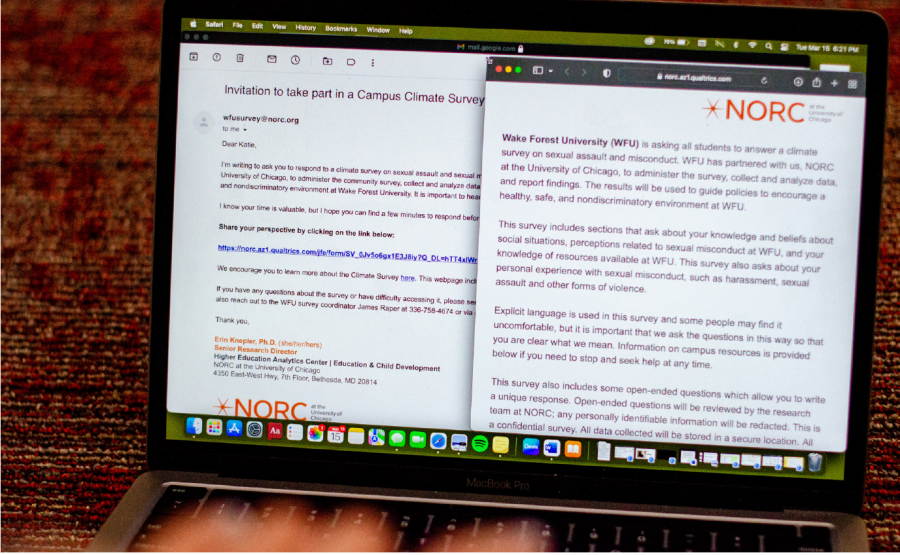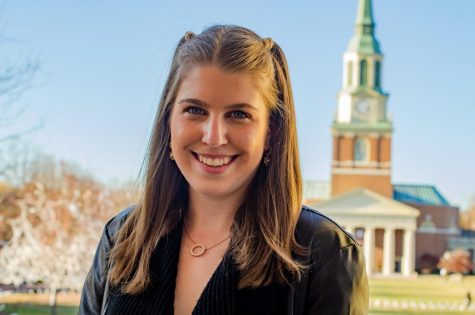University conducts campus climate survey
Students can participate in the Sexual Misconduct Campus Climate Survey starting on March 15
Student Government leaders and members of the SAPSA committee hope to receive a high student response rate so the survey can best represent student experiences and perspectives.
March 16, 2022
Wake Forest University students were invited to complete the Sexual Misconduct Campus Climate Survey on March 15.
Campus climate surveys, according to Pilar Agudelo, co-chair of the Sexual Assault Prevention, Support and Accountability Committee (SAPSA), are conducted at multiple universities to measure student experiences and perspectives so that universities can reflect on their policies, programs and overall environment of campus. This survey will focus solely on Wake Forest’s campus and will center around the topic of sexual misconduct and assault.
“It’s a survey that is supposed to not only allow Wake Forest to understand the students, but it’s an opportunity for every single student — rather than a few central leaders around campus — to share their own stories and experiences,” Agudelo said. “It’s a way to get every single student to be able to share something, regardless of if it’s positive or negative or anything in general.”
In 2019, Student Government passed a resolution urging the university to conduct a campus climate survey. Although action did not occur as a result of that previous legislation, several staff members, President Susan Wente and co-chairs of the SAPSA Committee, Jackson Buttler and Pilar Agudelo, recently pushed for the creation of the survey.
“Pilar and I worked on getting a resolution written that would endorse the idea on behalf of the student government, which passed,” Buttler said. “Once that resolution was passed, and the university administration indicated that this was something that they were willing to pursue, we formed the SAPSA Committee, which helped in getting the survey rolled out and in analyzing the data that would come after the survey was completed.”
The vendor for the survey, the National Opinion Research Center (NORC) worked with the President’s office on the actual construction of the survey, while Agudelo and Buttler worked to advise the survey.
“Our role is to help in advising the rollout of the survey and eventually advising in terms of how we respond to the report of the survey,” Agudelo said. “So right now, a lot of our work has been preparing promotional stuff, getting ready to help with the rollout of the survey and making sure we’re getting a lot of responses. Ultimately, the best and most effective way for this survey to be successful is to have a good response rate.”
Leading up to the release of the survey, the Wake Forest Student Government Instagram account, @wake_sg, posted social media graphics explaining the survey and its purpose. Student Government also intends to talk to student organizations about how to best inform students about the survey and its importance.
“Our hope is that this is something students appreciate and want to see succeed just as much as we do,” Buttler said. “I think something that we want to make clear is that change can’t be made unless it is a community effort. This is something that could certainly affect change if students take it seriously and participate, which is why we’re passionate about getting the word out and ensuring that we get as high a response rate as possible.”
He continued: “If we get a response rate that’s below 10% or in the teens, I don’t think we would be able to make decisions that are reflective of student experiences, and we probably wouldn’t be able to create policy that is centered around supporting survivors and trying to make Wake Forest a safer community for everyone.”
Agudelo and Buttler hope the responses of the survey will be as reflective of the student population as possible, reaching all demographics.
Buttler discussed how the survey vendor NORC does its best to ensure the responses of the survey are representative of the entire campus community.
“It’s going to be a continual conversation with [NORC] so they can update us throughout the time that the survey is out,” Buttler said. “Say that maybe one certain demographic group hasn’t answered in a way that is equivalent to other demographic groups across campus, then administrators or the SAPSA Committee can create targeted interventions to get these groups to take a survey to ensure that we are hearing all the voices across campus.”
In this process, student input has been paramount.
“We’ve been in and out of meetings with [NORC] and the Office of the President, and they really do appreciate the feedback that we’ve given as students, which has been a really great experience,” Buttler said.
Agudelo noted that various campus communities can foster conversations by promoting the goal of the survey and echoing the desire for diverse responses.
“I think another part of it is relying on our committee members, there are 20 committee members in total,” Agudelo said. “And we’re all from different facets of campus. We all have different connections on campus — Greek life, non-Greek life, students of color, women, men, nonbinary, etc.”
“We can’t cover every identity on campus, and we’re not from every single corner of campus. But the hope is that through word of mouth and through people who are passionate about this work, we’re all having conversations with people in our vicinity, and then that way we get the responses that we need.”
Agudelo emphasized that the hope is for students to feel secure and comfortable when taking the survey.
“We’re focusing on making sure [students] have the resources [while taking the survey] and making sure they have the support services they need,” Agudelo said. “If they need to step away from the survey, it saves, and you don’t have to do it all in one sitting. You can take a break from answering questions and reach out to support services on campus if you need to.”
Wake Forest students have been sent an email containing the survey. The survey should take about 20 minutes to complete, according to a graphic provided by Student Government, and all information collected is confidential. The survey is slated to close on March 31.















